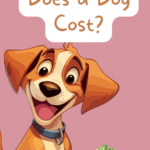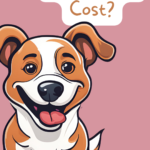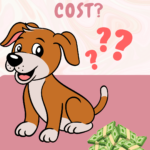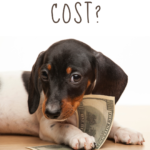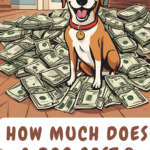Man’s best friend comes with a price tag! Bringing a new dog home can be an exciting adventure, but how much does a dog cost? Dogs can be expensive, not counting all the stuff you have to purchase to take care of them.
Plus, there are some ongoing fees to consider, like vet bills and food. The costs of dog ownership can quickly add up, so it’s important to budget for them!
We’ll break down all of the expenses in this article, helping you budget accordingly while keeping your pup happy and healthy!
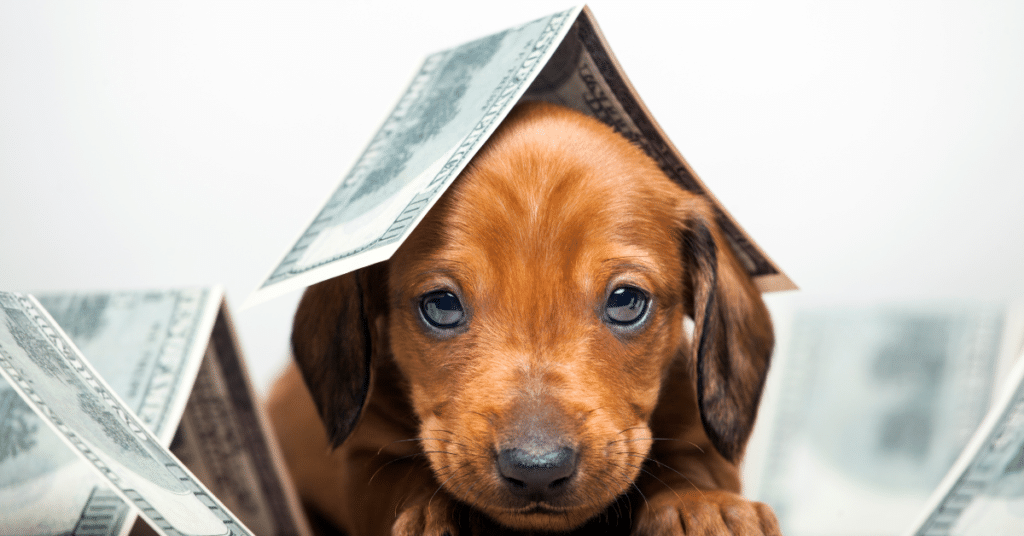
Expenses for New Dogs and Puppies
Adoption and Breeder Fees
Bringing home your dog comes with an initial financial cost. No matter where you get your dog from, you’re likely going to be paying for them. The cost of getting your dog can vary widely, though, depending on whether you choose to adopt from a shelter or purchase from a breeder.
Adoption fees are generally lower than purchasing a dog from a breeder, but they do still contribute to the cost of ownership. These fees vary widely depending on where you adopt from and may be based on the amount of care the dog requires. For instance, dogs in need of spaying or neutering sometimes cost more than dogs who arrived at the shelter spayed or neutered.
These fees go to pay for the dog’s vaccinations and other basic needs. You can expect to pay somewhere between $50 to $300 at a shelter or rescue organization. Third-party rescues tend to cost more than local, government-funded shelters.
The price of a puppy from a breeder can vary widely, too. It isn’t odd for a purebred puppy to cost thousands of dollars, especially among larger breeds. Often, larger dogs cost more than smaller ones, as the breeder has to pay more for food, housing, and vet care.
Simply put, larger dogs cost more to breed, so their puppies cost more, too. For instance, a pedigreed Great Dane will often cost $1,000 to $2,000, while a Beagle rarely costs more than $1,000.
Dogs that require more vet care and are generally less healthy are often much more expensive, too. For instance, English bulldogs have a high incidence of birthing difficulties and often require veterinary care. For this reason, a puppy can easily cost $4,000.
Popularity plays a role, too. The French Bulldog is currently the most popular dog in the United States and is also one of the most expensive! Puppies often start at $4,000 but can easily reason $7,000 or more.
Vet Visits and Vaccinations
Your dog requires regular vaccinations and preventative care. While your dog will need to visit the vet annually throughout their life, puppies (and even newly adopted adult dogs) need to visit several times in the first year.
Exactly what a new dog needs depends on their age and what they’ve previously received. For instance, many shelters and breeders provide at least some of a dog’s vaccinations. In some cases, newly adopted adult dogs may not need any more vaccinations for a year or more.
If you’re adopting from a breeder, ask what vaccinations are included in the puppy’s price. Often, breeders will give puppies their first round of vaccinations before sending them to their forever home.
Whether your dog needs vaccinations or not, you should plan on visiting the vet for a comprehensive exam after adopting your new dog. It’s always a good idea to have a baseline of health established.
A comprehensive checkup for a puppy that includes vaccinations, spay/neuter surgery, and microchipping can cost anywhere from $340 to $510. A basic checkup for a dog that doesn’t require any of these services may cost as little as $50.

New Dog Supplies
There are some supplies you’ll need to purchase for your pup upfront. Many of these things won’t need to be re-purchased for some time, like bedding and food bowls. Buying higher-quality items may even save you money in the long run.
Here’s a breakdown of what you can expect to purchase:
- Bedding: A comfortable bed is essential for your dog’s sleep. Prices range from $20 to $150 depending on size, material, and brand.
- Food and Bowls: High-quality dog food is crucial for your pet’s health. Expect to spend $30 to $80 on a month’s supply, depending on the dog’s size and dietary needs. Food and water bowls typically cost around $10 to $30.
- Leash and Collar: A sturdy leash and collar are necessary for walks. Prices vary widely, but you can find basic options for $10 to $30 and higher-end choices for more.
- Toys: Interactive toys, chew toys, and balls can provide entertainment and mental stimulation. Budget around $30 to $100 for a variety of toys.
- Crate or Kennel: If you plan to crate train your dog, you’ll need a suitable crate. Prices start around $50 and can go up depending on size and features.
- Grooming Supplies: Brushes, combs, nail clippers, and shampoo are essential for maintaining your dog’s hygiene. Expect to spend around $30 to $50 on initial supplies.
These are only estimated dog costs, and there are many potential ways to save money. If you know you’re adopting a dog, keep an eye out for sales and purchase the necessary equipment over several months.
Some breeders and shelters will include some starting items for new families. For instance, a shelter may include the bed the dog has been using. Many breeders include collars, food, and similar items to ease the puppy’s transition to a new home. Check before you start buying things so you don’t purchase anything you don’t need!
How Much Does a Dog Cost? Ongoing Costs
Once you’ve survived the initial puppy rush (or adopted a fully grown dog), it’s time to start planning for ongoing expenses. Let’s break down the monthly costs of dog ownership.
What Is the Monthly Cost of Raising a Dog?
The monthly cost of owning a dog can vary widely depending on your dog’s size and breed. Larger dogs are typically more expensive than smaller dogs. Their stuff simply costs more. They eat more, require larger (more expensive) toys, and tend to have higher vet bills.
That said, this isn’t necessarily always the case. Vet bills will likely be your biggest expense and can add up quickly. A smaller dog with health issues will cost more to care for than a larger, healthy dog.
Of course, you often cannot control your dog’s health, but some breeds have more health problems than others. If you adopt a less healthy breed, plan on spending more time on your dog’s care.
Here’s a general list of monthly expenses you should plan for:
- Food: Your pup’s gotta eat! Expect to pay anywhere from $20 to $80 a month, depending on the food you purchase and your dog’s size. Be sure to read the dog food nutrition label to ensure the food you’re purchasing is high-quality. The type of dog food matters significantly. Raw dog food costs much more than kibble!
- Treats: While training, you’ll go through lots of treats. Budget around $20 for the few months directly after adopting your dog, but plan on this cost decreasing over time. You may also want to consider purchasing a good dog multivitamin. Seniors may also benefit from senior dog supplements.
- Toys: All dogs need toys, but some dogs will need more regular toy purchases than others. Plan for a small monthly allowance, at least. Puppies often require more toys than adults, too. Purchase dog toys specific to your dog. For instance, dogs with high prey drives benefit from fetch toys. Dogs that like swimming may like water dog toys.
- Grooming: Dogs with high grooming needs may require professional grooming, costing as much as $100 a month. Dogs with low grooming needs may not have any ongoing grooming costs at all.
- Preventatives: For your dog’s health, it’s important to put them on a preventative medication. Monthly preventatives are sold according to your dog’s weight, but it’s often below $50 a month (even for very large dogs).
- Unexpected costs: Life happens, especially when you have a hyper puppy. Set aside a little extra each month for when your puppy decides to eat through their bedding or destroy that new toy in five minutes.
Everyone’s situation (and dog) is different. These general guidelines should get you started, but you’ll likely need to adjust each category based on your dog’s needs.
There are tons of ways to save money in these categories if you play it smart. For instance, using a quality dog food storage container can keep your dog’s food free from bugs and mice, reducing your long-term costs. Storing dog food correctly is important to maintain it’s nutrition, too.
How Much Does a Dog Cost Per Year?
One of the most accurate ways to determine how much money you need to set aside for your dog is by examining yearly expenses. After all, you’ll be spending more in some months (like when your dog has its annual checkup) and less in others.
Here’s a handy table to give you a general idea of yearly expenses:
| Expense | Low | High |
| Adoption Fees | $0 | $7,000 |
| Spay/Neuter fees | $250 | $525 |
| Microchip | $0 | $95 |
| Initial vet visit | $50 | $550 |
| Collar | $5 | $60 |
| Harness | $5 | $80 |
| Leash | $10 | $150 |
| Food and water bowls | $5 | $35 |
| Crate | $25 | $575 |
| Bed | $30 | $250 |
| Grooming items | $5 | $100 |
| Cleaning supplies | $10 | $55 |
| Toys | $20 | $75 |
| Treats | $15 | $35 |
| Ongoing vet care | $275 | $450+ |
| Food | $300 | $1,200 |
| Totals | $1,005 | $11,235 |
Remember, these are just ballpark figures. The vet expenses we included are for regular, preventative care only. If your dog has an accident or illness, expect to potentially spend thousands. (You may want to consider pet insurance to help cover these costs.)
As you can see, the yearly cost of a dog can vary substantially. You may spend a little over $1,000 for everything, or over $10,000. The biggest factors in price will depend on the type of dog you purchase.
Additional Dog Expenses to Consider
We’ve covered the basics thus far! But let’s get real: Dogs are anything but predictable. Things happen sometimes, and occasionally, these things are very expensive.
Health Costs: Emergency Visits and Dental Hygiene
Out of all the doggie expenses you’ll need to pay, health costs are by far one of the most expensive. No one plans on their pup needing an emergency vet visit, but it happens all the time.
That midnight dash to the vet for eating a whole sock can put a serious dent in your wallet.
Emergency vet bills due to illness or injury can easily cost thousands. Luckily, you’ll only have to pay the bill once. Chronic diseases are a different matter, though, and can permanently add to your monthly expenses. Medications used to control most chronic diseases are dosed based on your dog’s weight, so larger dogs will be more expensive in almost every instance.
Dental hygiene is also exceptionally important for dogs. Over 80% of dogs over the age of three have dental disease. To prevent these problems, your vet may recommend regular dental cleanings, which often occur while your dog is under anesthesia. These cleanings are typically around $500 to $1,000, but avoiding them can be even more expensive.
A dog root canal can cost as much as $3,000 for a single tooth.
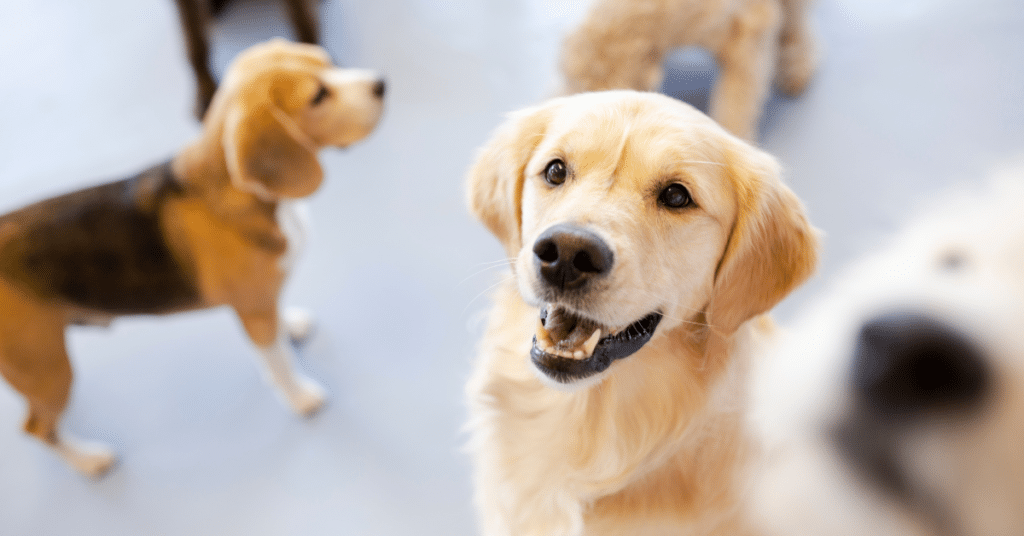
Dog Enrichment: Boarding, Training, and Day Care
Your pup needs a bit more than just food and shelter to thrive. They also require mental and physical stimulation. While you can do many of these for free at your home, some dogs may need a little extra.
All dogs need training, and we highly recommend considering a professional trainer. Training in a group setting goes beyond just learning commands. It gives your dog exposure to other dogs and people, leading to a better-adapted pup. If you want your dog to behave well in public, the best way is to train them in public!
Dog training is often cheaper than many pet parents believe. For basic training, you can expect to pay around $100 for a several-week-long course. Even if you want your dog to complete more advanced training, your costs will probably be around $300 in total.
These costs are for group classes, which we recommend. Not only are group classes cheaper, but they also provide more socialization (which is the best part of professional training for most dogs). Individual classes will cost closer to $50 or $75 a session.
Group classes go over all the basics, like how to potty train a puppy. Individual classes are best for reactive dogs.
Some dogs may also benefit from doggie daycare, especially if you’re gone for much of the day and your dog is very active. Usually, these services cost $30 to $50 for a full day. You can see how that can add up very quickly, though. Some people may pay as much as $250 for a week of doggie daycare sessions.
Depending on your lifestyle and your dog’s needs, a daily dog walker may be needed. Some dogs need lots of exercise a day, which is hard to accomplish if you have a full-time job.
Luckily, dog walking costs are far lower than dog daycare. An hour-long walk costs around $10 to $15.
Boarding is another consideration if you plan to go out of town. A quality boarding facility will cost several hundred dollars for a week-long trip. Luckily, though, you probably won’t be paying this fee regularly.
The best way to save money in this category is to exercise your dog at home. You’ll likely need to adjust your exercise and enrichment activities as your dog’s needs change. For instance, senior dogs need different enrichment than puppies!
Grooming Costs
Grooming costs vary widely. Some dogs only need a quick brushing at home, which a typical pet parent can accomplish themselves. Others may need professionally trimmed every couple of months.
How much a trim costs depends on your dog’s breed. A quick trim and bath may only cost $50 to $75. A Poodle or more intensive dog breed may cost closer to $100 to even $200. Going to a very high-quality groomer will cost more, especially if you want a more challenging trim.
You can save money by doing as much at-home grooming as possible. Brushing your dog regularly to prevent matting will save the groomer time, for instance. Bathing your dog at home can also reduce your grooming costs.
Skin issues and allergies may also increase a dog’s grooming needs. Dogs with itchy skin may need extra care from the groomer.
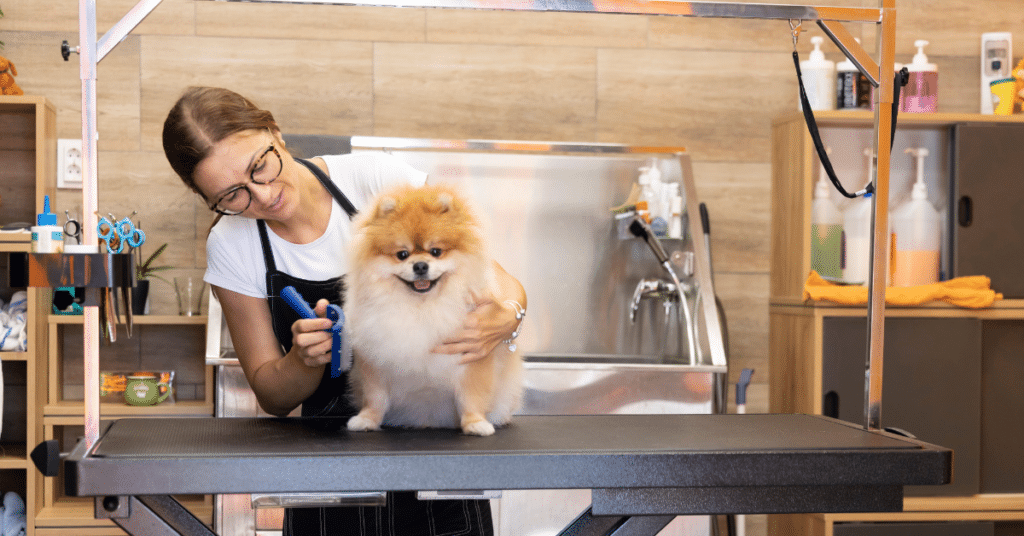
Pet Insurance and Deposits
As we’ve discussed, emergency vet care can cost a lot. To help reduce these unexpected health costs, many pet owners invest in pet insurance. Similarly to human health insurance, pet insurance pays for some of a dog’s healthcare costs (though typically only during an emergency). It won’t cover everything, but it can provide a nice safety net.
In exchange, you pay a monthly fee. This fee varies widely, but your location and dog’s age play the biggest role. Expect to pay more in urban areas where vet costs are higher. Most dogs will cost around $30 to $50 per month.
Older dogs will have much higher bills than younger dogs, too. Some pet insurance plans may not cover older dogs at all. The more likely your dog is to have an emergency vet visit in the eyes of the insurance company, the higher your monthly cost will be.
You should also budget for any potential pet deposits. Some apartments and rental houses require a pet deposit, which can potentially cost $500 or even more. These deposits can bulk up your initial costs, though you likely won’t have to re-pay this deposit.
Additional Dog Expenses Worth Budgeting For
We’ve covered the bulk of expenses you need to look out for. However, there is one more cost that’s commonly overlooked by pet owners:
How Much Is End-of-Life Care for Dogs?
No one likes to think about it, but it’s important to be prepared. Saying goodbye to our furry friends is never easy, and it can also be expensive. Your costs will depend mostly on what you decide to do with your pup and their size.
On average, “pet hospice” costs around $300 to $650. This includes end-of-life care and medication that’s required to make your dog comfortable. Often, this will be performed at the vet’s office, but some vets may offer to come to your home.
Communal cremation (where the pet’s ashes aren’t returned to the family) typically costs around $50 to $150. Private cremation (where the pet’s ashes are sent back to the family) costs closer to $100 or $300. These fees include the urn, too, which is often customized with the pet’s name.


